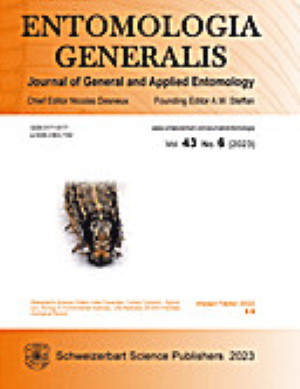作为环境友好型 IPM 工具的枯梢诱捕植物:中国成功使用香根草的案例研究
IF 4.6
1区 农林科学
Q1 ENTOMOLOGY
引用次数: 0
摘要
死端诱捕植物是指对目标害虫的产卵和其他活动具有高度吸引力,但害虫无法在其上完成发育、繁殖或生存的植物物种。由于其独特的杀虫机制和环境友好特性,近年来受到越来越多的关注。可用作诱捕植物的种类很多,但能用作死端诱捕植物的却很少。这些植物通常被用于禾本科作物、十字花科蔬菜和其他种植系统中的鳞翅目害虫防治。目前,香根草(Chrysopogon zizanioides)作为化学农药的替代品,被广泛应用于中国南方水稻螟虫的虫害综合防治(IPM)中。本文列举了可用作死角诱捕植物的植物种类,以及目标害虫和相关耕作制度。此外,还综述了死端诱捕器的诱杀原理和杀虫机理,并介绍了香根草作为死端诱捕器在水稻螟虫 IPM 中的应用。还讨论了死结诱捕植物保护作物的未来研究方向。本文章由计算机程序翻译,如有差异,请以英文原文为准。
Dead-end trap plants as an environment-friendly IPM tool: A case study of the successful use of vetiver grass in China
A dead-end trap plant is a plant species that is highly attractive for oviposition and other activities of target pests, but on which they cannot complete their development, reproduction or survival. Due to its unique insecticidal mechanism and environment-friendly characteristics, it has received increasing attention in recent years. There are many species that can be used as trap plant, but few of them can be used as dead-end trap plants. These plants are commonly utilized for lepidopteran pest management in graminaceous crops, cruciferous vegetables and other cropping systems. At present, vetiver grass, Chrysopogon zizanioides, is widely used in the integrated pest management (IPM) of rice borers in southern China as an alternative to chemical pesticides. This article lists plant species that can be used as dead-end trap plants, together with the target pests and relevant cropping systems. In addition, the trapping principle and insecticidal mechanism of dead-end traps is reviewed, and the application of vetiver grass as a dead-end trap in rice borer IPM introduced. The future research directions of dead-end trap plants towards the protection of crops are also discussed.
求助全文
通过发布文献求助,成功后即可免费获取论文全文。
去求助
来源期刊

Entomologia Generalis
生物-昆虫学
CiteScore
7.10
自引率
18.80%
发文量
72
审稿时长
>12 weeks
期刊介绍:
Its scope covers all aspects of basic and applied research dealing with insects and more broadly with arthropods inhabiting wild, agricultural and/or urban habitats. The journal also considers research integrating various disciplines and issues within the broad field of entomology and ecology.
Entomologia Generalis publishes high quality research articles on advances in knowledge on the ecology and biology of arthropods, as well as on their importance for key ecosystems services, e.g. as biological control and pollination. The journal devotes special attention to contributions providing significant advances (i) on the fundamental knowledge and on sustainable control strategies of arthropod pests (including of stored products) and vectors of diseases, (ii) on the biology and ecology of beneficial arthropods, (iii) on the spread and impact of invasive pests, and (iv) on potential side effects of pest management methods.
Entomologia Generalis welcomes review articles on significant developments in the field of entomology. These are usually invited by the editorial board, but proposals may be sent to the Editor-in-Chief for preliminary assessment by the editorial board before formal submission to the journal. The journal also considers comments on papers published in Entomologia Generalis, as well as short notes on topics that are of broader interest.
 求助内容:
求助内容: 应助结果提醒方式:
应助结果提醒方式:


